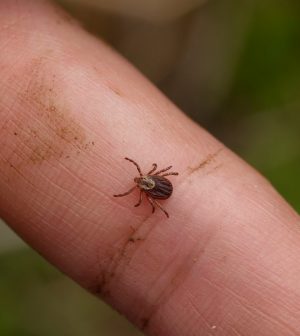- Skip Storing This Everyday Product in the Fridge Door
- Green Tea + B3 Pairing May Boost Brain Health
- Navigating Your Midlife Crisis: Embracing New Possibilities
- City Raccoons Showing Signs of Domestication
- Mapping the Exposome: Science Broadens Focus to Environmental Disease Triggers
- One Week Less on Social Media Linked to Better Mental Health
- Your Brain Changes in Stages as You Age, Study Finds
- Some Suicide Victims Show No Typical Warning Signs, Study Finds
- ByHeart Formula Faces Lawsuits After Babies Sickened With Botulism
- Switch to Vegan Diet Could Cut Your Greenhouse Gas Emissions in Half
Steady Rise in U.S. Cases of Tick-Borne Babesiosis Disease

Cases of a tick-borne parasitic disease have steadily increased in recent years, a new study shows.
Rates of babesiosis increased an average 9% a year in the United States between 2015 and 2022, researchers reported in the journal Open Forum Infectious Diseases.
Further, four in 10 patients with babesiosis also were infected with other tick-borne illnesses like Lyme disease, researchers said.
“These findings suggest that clinicians should have a heightened vigilance of co-infection of other tick-borne illness among patients admitted with babesiosis,” said lead researcher Dr. Paddy Ssentongo, an infectious disease fellow with Penn State Health Milton S. Hershey Medical Center. “Ticks can carry other bacteria that cause Lyme disease and other tick-borne diseases like anaplasmosis and ehrlichiosis.”
Babesiosis is sometimes referred to as “American malaria,” because the babesia parasite infects a person’s red blood cells similarly to malaria, researchers explained in background notes.
The parasite is transmitted by the bite of black-legged ticks, and is found primarily in Northeastern and Midwestern states.
Infected people often experience flu-like symptoms, researchers said. The disease can be deadly for older adults, people with compromised immune systems or for those who lack a spleen.
For the study, researchers analyzed national health data for more than 250 million people in the United States and identified more than 3,500 people infected with babesiosis between October 2015 and December 2022.
Cases peaked during the summer months, and most occurred in Northeastern states, results showed.
Of those diagnosed with babesiosis, 42% also had one or more additional tick-borne infections. Of those patients, 41% had Lyme disease, results show.
However, the presence of more than one infection from ticks did not increase people’s risk of death.
“Having both babesiosis and Lyme disease seemed not to be associated with worse mortality,” Ssentongo said, noting the finding was surprising. “It’s speculated that the concurrent presence of other tick-borne infections in the blood could alter the immune response by possibly ‘boosting’ it to effectively fight infections.”
It’s also possible that doxycycline — the first-line antibiotic treatment for Lyme disease — might also be effective against the babesia parasite, Ssentongo said.
“For patients with babesiosis, we add on doxycycline as we’re investigating whether or not the patient has Lyme disease or other tick-borne diseases, and we’ve seen better outcomes at our medical center with this approach,” Ssentongo said in a Penn State news release.
Climate change might play a role in the higher rates of babesiosis, increasing the presence and activity of ticks across a wider area, Ssentongo said. Warmer weather and heavier rainfall also could influence the activity of animals like deer that serve as reservoir hosts for the babesia parasite.
“If you live in areas where babesiosis is endemic, mostly states in the Northeast and the Midwest, take precautions, especially during the summer months,” Ssentongo said. “Practice tick-bite prevention practices. Wear long-sleeved shirts and pants and light-colored clothes. Use tick repellant and check for ticks after spending time outdoors.”
More information
The U.S. Centers for Disease Control and Prevention has more about babesiosis.
SOURCE: Penn State, news release, Oct. 8, 2024
Source: HealthDay
Copyright © 2025 HealthDay. All rights reserved.










